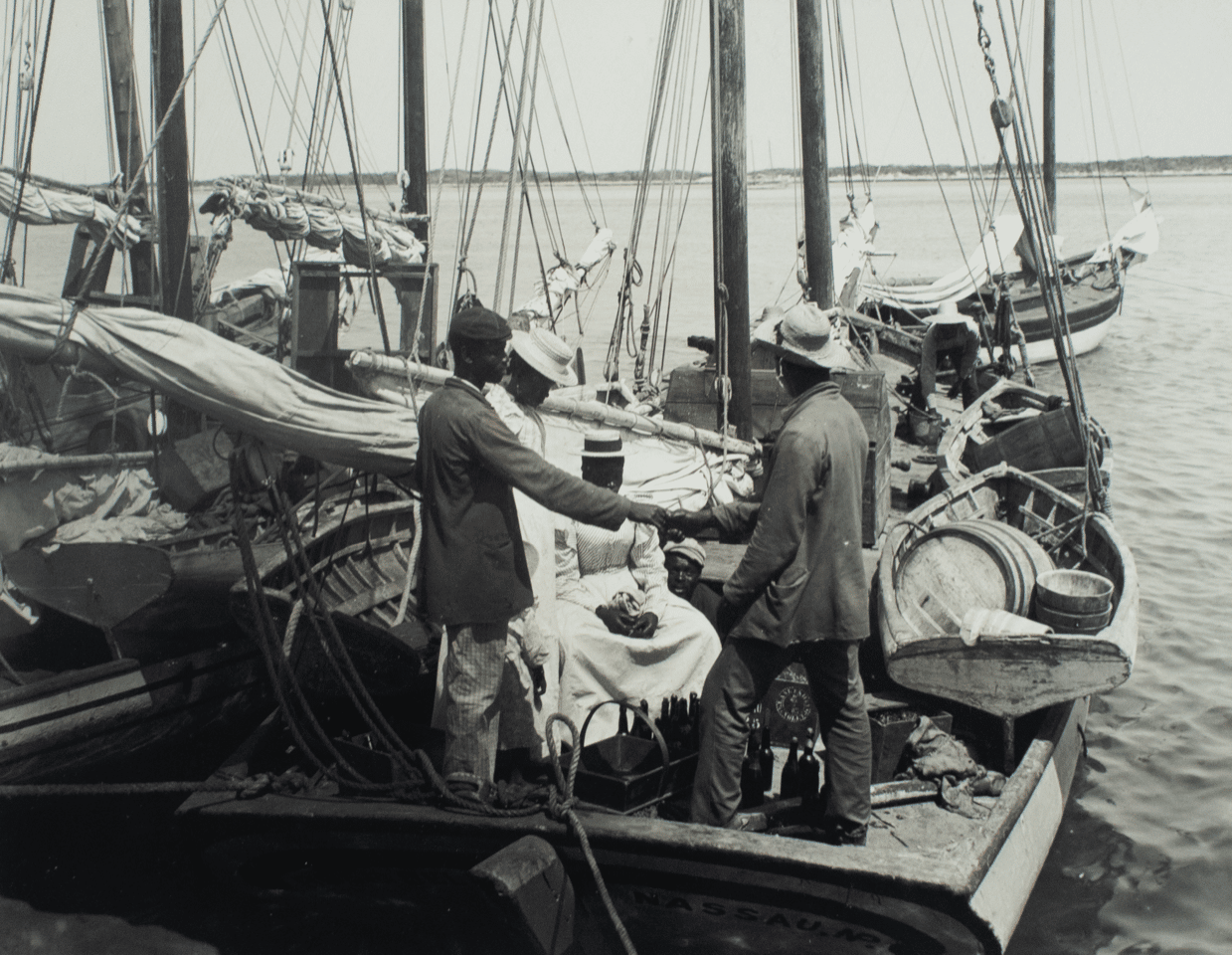
By Natalie Willis
One would imagine this a typical scene along the Nassau coastline in the 1920s, as so much of our history – painful or profitable – was tied to the sea’s comings and goings. “Doc” Sands gives us what appears to be commonplace, but when we situate this image in the context of its time, and in our broader Bahamian history, things begin to take an exciting turn. Bottles and barrels that appeared to be ordinary fare now begin to remind us of prohibition and bootlegging, and the men shaking hands could very well be in the middle of a handoff. Of course, much of the imagery photographed at this time was staged out of necessity – things needed to be reasonably still for a prolonged time for the image to be taken appropriately. Was Sands staging this image of prohibition and illicit-alcohol Nassau at its roaring start?
James Osborne “Doc” Sands was born in 1885 in Rock Sound, Eleuthera, and is noted one of the first Bahamian photographers. The second of six children, his parents moved him to Nassau for what they felt to be a better education, and at age 18 he was handed over the photo studio of his mentor, American photographer Jacob Frank Coonley. Coonley and his contemporary William Henry Jackson (also American) were well known for their work, and now historically for their contributions to building and framing the picturesque, tropical images of The Bahamas at the start of its tourism industry, and Sands took up the mantle at a somewhat tender age.
As contentious and challenging as it might be to see some of these images today, the shifting from expatriate eyes to local is hard to discern in the photographs, but undoubtedly present. Whereas Coonley and Jackson had a certain distancing between themselves and their Bahamian subjects, Sands begins to break that distance down – though still of course with the colonial power structures of the time. In over 200 self-produced postcards along with his regular commissions in the photo studio, Sands’ posing and placing of Black and Brown bodies in the frame is part and parcel of this manufacturing of the country as a Caribbean idyll, but Sands photos help to give us a very particular shift in time. From the ending of slavery through to the period of “apprenticeship” and the colonial hierarchy from slavery that was perpetuated through more subtle, still insidious means of oppression. From slavery to its abolishment, to post WWI, Sands gives us his particular way of looking at The Bahamas of his time and his position in society, with all its biases.
Bay Street in Nassau, as we currently know it, was partly built on the profits of these particular roaring twenties – the harbour’s renovations, in particular, taking place in this time. Post-WWI Nassau was in serious debt after its efforts to be seen as a “respectable” and contributing colony to the efforts, amounting to around $130,000 – roughly around $3,200,000 in today’s time which was instead a lot for the still-developing colony – funds from blockade running in the late 1800s long gone. The tourism during the war declined significantly, as was to be expected, and local economies suffered, and food supplies were scarce and expensive though there was less expendable currency floating around in those days. Money was raised in support of the war effort, though some of it found itself hidden by Family Islanders in the archipelago. The decline in tourism profits and difficulties with food supplies continued and was mainly felt in 1917 when the US entered the war.
The American National Prohibition Act was ratified in 1919, tailing on a previous act to limit alcohol percentage of spirits as an effort to save grain during the war, but bolstered by the work of “dry” activists at the time – most notably the Woman’s Christian Temperance Union as well as Protestant groups and some Republicans and Democrats alike. In the full ban of alcohol production, manufacture, sale and consumption in the US come 1920, The Bahamas saw its opportunity. Though the motto of the country may have formerly read “Expulsis Piratis, Restituta Commercia” (Latin for “Pirates Expelled, Commerce Restored”), piracy never indeed left our islands, it merely changed tack. In the pirate-style smuggling and stealing of liquor, the country certainly did find its commerce restored, seemingly overnight. Many Bahamian families – on the spectrum of society – found themselves shaking off the debt and drudgery post-war, and making their fortunes rum-running from Bimini to Florida. Sands’ photograph becomes a kind of illustration of the start of America’s lawfully-forced temperance that encouraged less-lawful opportunists in our still-British colony who fully took advantage of Britain’s lack of alcohol ban on its colonies. Piracy, Rum-Running, or tax evasion – all Caribbean pillars of a sordid history of illicit activity, but a colourful history nonetheless.